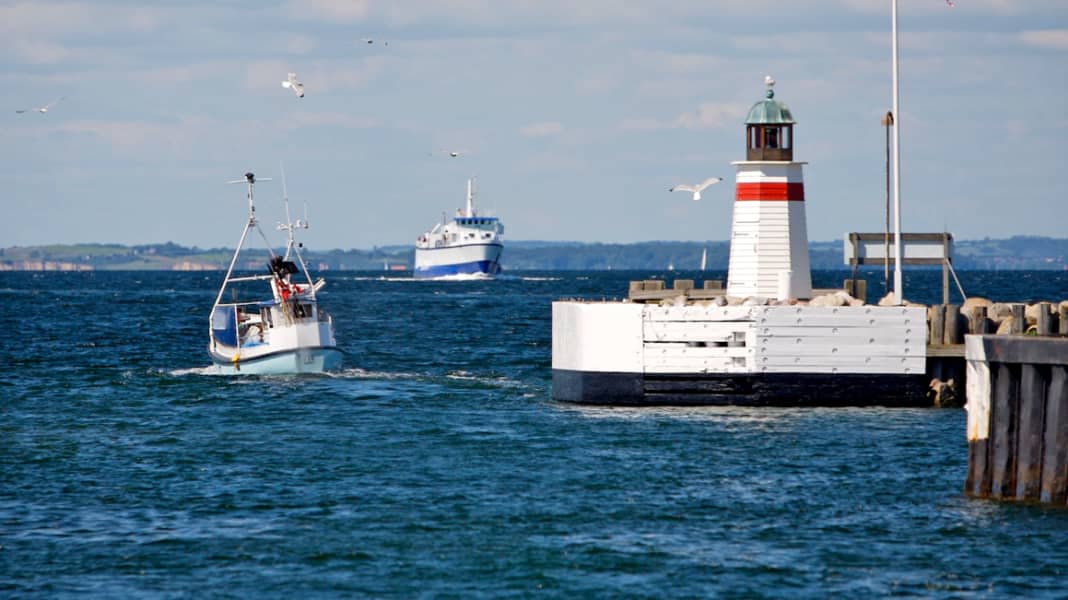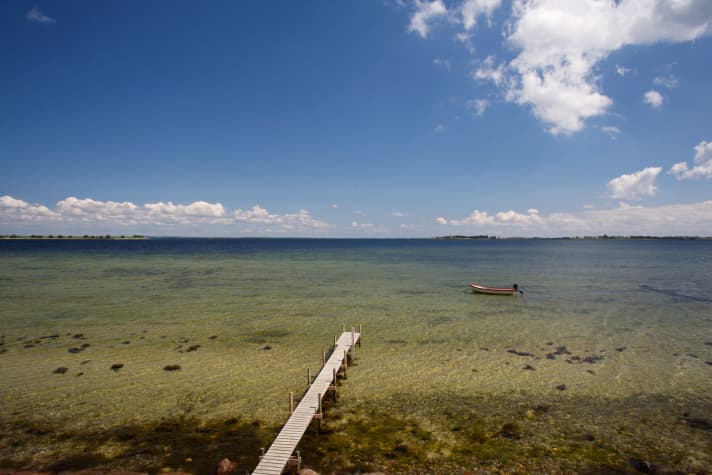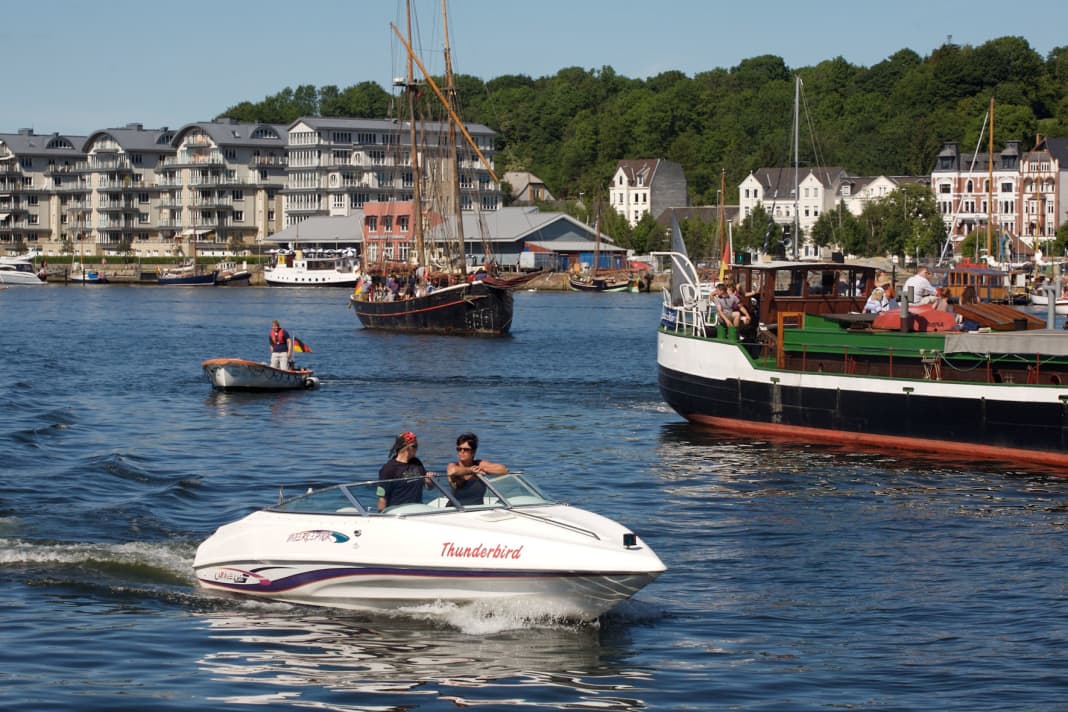







Let's clear up a widespread misconception right at the start: The Danish South Seas - this name was not invented by our northern neighbours to boost boat tourism. Sure, most of the area is as flat as a lagoon, but the distances are anything but pacific. Palm trees are potted at best, and what about the perpetual summer? Well, yes. "The South Seas is when the sun shines!" a colleague once wrote dryly.
No, as is so often the case, the translation is simply to blame, because we should actually be talking about the Danish Southern Sea - the sea in the south of Denmark. Or better still, the archipelago of South Funen, as that is the original name. In German, however, after the North Sea and the Baltic Sea, it simply became the South Sea - that's how easy longing is born!

It doesn't matter whether the comparison with the original on the other side of the globe is a little off or not: what is certain is that the picturesque island world between the Great and Little Belt is one of the most beautiful things our corner of Europe has to offer for skippers. What does it matter if you have to slip into your oilskins in August? On Tahiti, Tuvalu and Tonga you won't get a Pølser with Tuborg!
Flensburg

Our journey begins in Flensburg: at the southern end of the fjord lies Sonwik Marina, a former naval site that has long since been transformed into a modern marina, which is easy to spot from the water thanks to its long row of floating houses.
This is the base of Motorbootcharter Flensburg, and company boss Stephan Post hands us the keys to "Smilla", a Saga 27, a cosy, Scandinavian pointed-rigged boat that will accompany us through the islands of southern Denmark for the next week.
From the Molenkopf, we take our first look across the Flensburg Fjord in glorious summer weather. The fairway is buzzing with activity: participants in the legendary Rum Regatta are gliding past under colourful pennants, bulbous cloth and creaking gaffs towards Flensburg. Steamers let their whistles roar and pleasure craft escort the historic armada into the harbour. The folk festival, with its eloquent, cheerful "prize-giving" on the day after the Rum Regatta, has been a firm fixture on the fjord's calendar of events for more than three decades.
Before we take a closer look at the hustle and bustle in the evening, we buy some provisions for the upcoming trip. The nearest shops (Edeka, Aldi) are about five minutes away by car on Fördestraße (L 249) heading north.
The Flensburg Fjord
The next morning, our little displacer is on a north-westerly course early and pushes its bow wave down the fjord. Despite the glorious weather, only a few white sails are dragging in front of us.
To starboard we pass the austere brick battlements of the naval school in Mürwik, the forge of naval officers since imperial times, and soon afterwards the incredibly charming Ox Islands off the Danish shore. Rolling hills frame the estuary on both sides.
A good hour later, we follow the buoy line through the bay of Rinkenæs with the towns of Gråsten, Egernsund and the well-equipped Minde marina to the north. To the south, the sandy wooden hook stretches far into the fjord, and the red "6" of the fairway in particular must not be cut on the land side (water depth less than 1 metre). The infamous buoy used to be known as the "mother-in-law": If you cheated her, she would let you run aground. In the meantime, a stately, lighted dolphin has taken over her position.
Behind Holnis, the Flensburg Fjord makes a short turn to the south-east before continuing around Brunsnæs Flak to the west-south-west. East of the Neukirchengrund shoal, the water area opens up, with Geltinger Bucht to the south and Sønderborg Bugt to the north. In windy conditions, you get a first taste of what is going on "out there".
Ahead, the red and white Kalkgrund lighthouse points the way to the open Baltic Sea. If the weather doesn't throw a spanner in the works, we want to sail back into the fjord from there in a week's time. For now, however, our course takes us to Sønderborg in the north.
Sønderborg (As)
The town on the Als Sound offers two good options for overnight stays. If you value peace and quiet, your own box and well-kept sanitary facilities, head for the Sønderborg marina before entering the sound. However, we leave the marina and castle to the left and look for a place in the city harbour south of the King Christian's Bridge. You have to turn a blind eye to the public toilets, but you are right in the centre of things on the promenade. Electricity and water are available. The harbour fee is paid - as is now the case almost everywhere in the region - at the machine at the harbour office.
There are two things to bear in mind when mooring: Firstly, there is a current in the sound, which can cause eddies, especially in the area in front of the lock; secondly, the pier is actually reserved for larger yachts, so you should try not to waste any space and go into the packet if necessary. The high pier is only partially suitable for smaller boats.
In addition to the exhibition in the ducal castle, the former defence positions on the Düppel redoubts, whose cannons and museum are reminiscent of the German-Danish War of 1864, are particularly worth seeing in Sønderborg. A time that is fortunately a long time ago. Back in the city, the Føtex market in Perlegade is the best place to buy supplies, a ten-minute walk from the harbour.
Dyvig (As)
The next stage leads through the tranquil Alssund with its gentle shores, where old manor houses are hidden behind tall trees. We cross the Augustenborgfjord and follow the Als Fjord further north-west to Stegsvig, which leads like a funnel into the north-west tip of the island of Als.
If you don't know it, you wouldn't expect to pass through here, but the narrow spit marked with poles takes us further inland. Dyvig now lies ahead of us, a short fjord that nestles into the landscape almost like a lake and is surrounded by idyllic nature.
If you want to anchor, you will find good, sheltered spots in the north-west corner of the bay. Fixed moorings with boxes are available in the recently enlarged harbour of the Badehotel on the northern shore and at the Dyvig Bådelaug jetty in the south. In addition to electricity, water and boat service, there is also a small shop where you can stock up on food and service items.
The next day we have a big challenge ahead of us: we want to cross the Little Belt to the east and be in Søby on Ærø by the evening. That's 25 nautical miles. A white veil has covered the sky and the wind is now blowing from the west at three Beaufort. It's supposed to freshen up later in the day; not too soon, we hope.
Fortunately, the wind and waves push us along at a leisurely pace at first.
Only when we pass the Tranesand shoal in the far north of Als abeam and turn the bow of the "Smilla" to the south-east do we also feel the stronger swell of the Little Belt under our stern. We now need to pay more attention at the helm so that the pointed gate doesn't get out of control and we don't take unnecessary serpentine lines.
Søby (Ærø)
Barely seven hours after casting off in Dyvig, we enter the harbour of Søby on Als between the pier lights. The Belt is behind us and we enter the pleasure craft harbour on the port side. The piers ahead and to starboard are reserved for commercial shipping, where slender patrol boats and two bulky car ferries are moored, while a pusher vessel in the dry dock is being sandblasted with a lot of noise and dust.
There's no question that Søby is the most industrial harbour on Ærø. Apart from the church on the hill, next to which is the Dagli Brugsen supermarket, the towering Elevator is the only landmark. But after a rough day on the Belt, we are not looking for cobblestones and rose bushes; the fresh beer on the terrace of "Øens Grill" right next to the marina is very welcome. The building also houses the sanitary facilities for guests. Mooring fees are collected directly at the jetty in the mornings and evenings; there is no vending machine.
Parallel to the coast of Ærø, at a distance of about two nautical miles, our course line continues south-eastwards after a calm night. We keep well clear of the Bjergene headland, but turn into the buoyed fairway to Ærøskøbing just behind it, between it and the small pasture island of Dejrø.
Ærøskøbing (Ærø)
There are two mooring options to choose from here: One is the town harbour, where you can moor alongside the wall, or the marina, to which a separate channel branches off from the main fairway and which offers a full range of services. In between are the ferry docks and shipyard.
Ærøskøbing could hardly be prettier: Old half-timbered captain's houses with sunken gables on narrow streets, behind the windows bric-a-brac and treasures from the Great Voyage - like the inconspicuous pair of porcelain dogs you meet on every corner: When the innocent four-legged friends turned their backs to the street, the woman in the house made it unmistakably clear that her husband was at sea and she was alone, very alone. However, if the poodles looked vigilantly outside, the sailor was at home - or was it the other way round?
The supply is also completely unproblematic in Ærøskøbing: there is a large Netto supermarket directly at the ferry landing stage on Vestre Allé, next to which "Lendas Griller" offers Danish specialities in all their variety: "Ristet", "rød" or "rød i svob", "hotdog rød", "ristet" or "fransk". You guessed it: it's all about the sausage here!
After our shore leave, we cast off the lines again in the early afternoon, as we still want to get to Svendborg on Funen. We set our sights on the passage between the small islands of Drejø, Hjortø and Skarø - each of which is worth exploring if you have more time.
Away from the path, it now becomes very flat, and you are well advised to keep to the buoy line without knowing the exact location. It starts in Højestene Løb and leads us into Svendborg Sund between Funen and Tåsinge.
Svendborg (Funen)
In Svendborg, which is the second largest town on Funen after Odense in the north, two marinas await touring skippers: the first facility, surrounded by a ring-shaped pier, is located about half a nautical mile east of the Sund Bridge, the second in the immediate vicinity of the town in the northern harbour.
We also opt for the second option because this harbour has recently been very successfully modernised. The floating sun terrace in the middle of the jetties is a wonderful place to end the day with a portion of fried fish from the harbour snack bar and a bottle of "Giraf", the strong beer from the island. All that remains to be said is that the catering options in Svendborg are excellent.
East of Svendborg, the buoyage in the sound changes: green is now on the port side and red on the starboard side. "Smilla" now follows the fairway again on a southerly course, between Tåsinge and Thurø and into Rudkøbing Løb.
This narrow section between Tåsinge and the much larger Langeland is also spanned by a wide bridge. At the same time, the fairway is so narrow and the surrounding water so shallow that the setting current sometimes pulls the buoys so far under water that only the top marks are visible.
Rudkøbing itself now lies off the port side, followed shortly afterwards by the island of Strynø on the starboard side. Its southern tip is marked by a cardinal buoy. The red and white approach buoy to Marstal soon comes into view ahead. The subsequent fairway finally brings us back to Ærø.
Marstal (Ærø)
No cruise through the Danish South Seas is complete without a visit to Marstal: it's not a law, but the cosy town in the far west of Ærø breathes so much maritime history that there is always something new to discover. From the Maritime Museum on Prinsensgade to the 1914 schooner "Bonavista", which is currently being restored at the shipyard using traditional craftsmanship.
It symbolises the great seafaring tradition of little Marstal; Danish author Carsten Jensen has created another literary monument to the town with his bestselling novel "We Drowned" (see box on the left). A highly entertaining rind - and just the right reading for a cruise through the area!
Although pleasure craft are also allowed to moor on the long quay wall of the town harbour, we motor past the shipyard with its dry dock and look for one of the few free spaces on the guest jetty of the pleasure craft harbour. In the high season, marinas in the Danish South Sea are usually full to the brim, especially at weekends. If you arrive late in the afternoon, you usually only have a place in the little packet on the harbour wall - but even that is no problem if you ask permission before coming alongside.
Unfortunately, Marstal is our last harbour on this trip through the Danish South Sea. We only have one evening left before the long journey back to Flensburg. But luckily there are enough cosy houses between Havnegade and Kirkestræde to celebrate a fitting farewell ...
-------
WHAT SKIPPERS NEED TO KNOW
The company Motorbootcharter Flensburg currently has two sports boats on offer, which are available from Marina Sonwik in Flensburg: the Saga 27 AK (see below) and a more sporty Bénéteau Antares 6.80. In addition to the Flensburg Fjord, the area around Als and the Danish South Sea, the company also suggests the Schlei as a cruising area.Information and booking: Motorboat charter Flensburg Post Yachtservice, Kanonenstr. 8, 24972 Steinbergkirche, Tel. 0176-83 16 37 36
The boat With a length of 8.15 metres, our Saga 27 AK "Smilla" offered a total of four berths in two separate cabins (fore and aft). A wet room with shower is located in the foredeck. The aft cabin is therefore best suited for two people (with children). A table can be set up in the bow cabin; if you don't want to convert it, use the folding table in the cockpit. The galley, which is equipped with a ceramic hob and fridge, is also located there.
Overall, the equipment was complete and met the expected charter standard, including colour plotter and TV with DVD player. The bow thruster is a helpful extra. When planning the trip, the maximum cruising speed of 7 kn should definitely be taken into account so that the days are not too long. However, around 20 nm can be comfortably achieved in suitable weather conditions. Prices per week: 599 to 1190 euros.
Driving licence A recreational boating licence is required for sailing in coastal waters.
The precinct The Danish South Sea is also a favourite spot for German skippers. The infrastructure leaves nothing to be desired, but it can get very crowded in summer. Due to the extensive buoyage, the area does not pose any major nautical challenges; however, good seamanship and thorough weather work are absolutely essential!
The berth prices On average, an overnight stay for a boat up to 9 metres in length costs around 110 Danish kroner (around 15 euros).
The cruise literature
- Harbour Guide Denmark:Danish Baltic and North Sea ports (...). 672 p., 735 plans, 18 x 24 cm, hardcover, Edition Maritim, Hamburg, 36 Euro, ISBN 978-3-89225-538-3.
- Jan Werner:Cruising Guide Denmark 1: Jutland, Anholt, Læsø. 264 p., 112 plans, 16.5 x 23.6 cm, paperback. Delius Klasing, Bielefeld, 29.90 euros, ISBN 978-3-7688-0350-2.
- Jan Werner:Cruising Guide Denmark 2: Funen, Zealand, Falster (...). 264 p., 128 plans, 16.5 x 23.6 cm, paperback. Delius Klasing, 29,90 Euro, ISBN 978-3-7688-0393-9.
- Jan Werner:Cruising guide Baltic Sea coast 1: Travemünde to Flensburg.176 p., 77 plans, 16.5 x 23.6 cm, paperback. Delius Klasing, 29,90 Euro, ISBN 978-3-7688-0990-0.
- Delius Klasing Sport Boat Chart Set 1: Kiel Bay and Round Funen. 35 area and detailed charts, 158 harbour plans, 60 x 42 cm, Delius Klasing, 69,90 Euro, ISBN 978-3-7688-3201-4.
- Carsten Jensen:We drowned people. Novel. 816 p., paperback. btb Verlag. 12,95 Euro, ISBN 978-3442741083.
The cruise stages
- Flensburg - Sønderborg: 21 nm
- Sønderborg - Dyvig: 12 nm
- Dyvig - Søby: 30 nm
- Søby - Svendborg: 22 nm
- Svendborg - Marstal: 19 nm
- Marstal - Sønderborg: 31 nm
- Sønderborg - Flensburg: 21 nm
Total 156 nm

